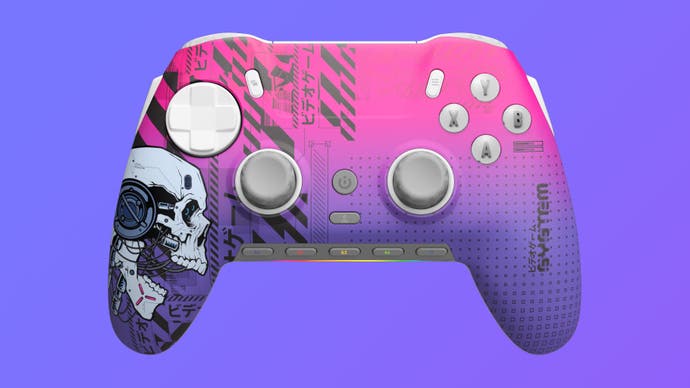Best PC controller 2024: the Digital Foundry buyer's guide to gamepads
The best first-party and third-party controllers tested.
Gamepads are simply the best option for a lot of PC games, thanks to their comfortable layout, analogue inputs and decades of love from game developers. Given that most console and mobile controllers also support PC, there's a huge range of options available too - from first-party options made by Microsoft, Sony and Nintendo to third-party models from Turtle Beach, Nacon, Scuf and more.
That can make finding the perfect controller tough, especially if you're a life-long PC gamer with no particular stake in the console war. To help you out - and for our own particular interests - we've tested dozens of the best gamepads on the market, sorted the wheat from the chaff, and picked out the best options for a range of budgets and gaming genres.
Best PC controller 2024
- Best PC controller: Xbox Wireless Controller
- Runner-up: Sony DualSense (PS5) Controller
- Best premium PC controller: Xbox Elite Series 2 / Elite Series 2 Core
- Best cheap PC controller: Turtle Beach React-R
- Best Hall Effect controller: Razer Wolverine V3 Pro
- Best cheap Hall Effect controller: GameSir G7 SE
- Best third-party PC controller: Asus ROG Raikiri Pro
- Most customisable PC controller: Scuf Envision / Envision Pro
- Runner-up customisable controller: Victrix Pro BFG
- Bonus - Best Android/iOS controller: Gamesir G8 Galileo
- Best of the rest: other controllers we tested
Best PC controller: Xbox Wireless Controller
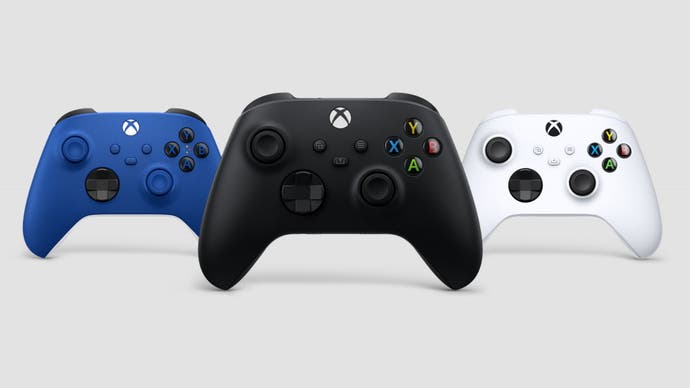
The best PC controller for most people is the £45/$49 Xbox Wireless Controller. This Xbox Series-era controller works well out of the box with the widest range of PC titles, offers wired, Bluetooth or 2.4GHz wireless connectivity and is available in a range of colours at a reasonable price. The Microsoft controller is also well-made, with responsive triggers and a large, comfortable shape.
However, the controller does have its downsides. Rather than charging via a USB cable, the Xbox Series controller takes AA batteries, requiring a £20/$25 Play and Charge Kit to support USB recharging. In addition, most PCs don't support Microsoft's low-latency 2.4GHz wireless out of the box, requiring a £34/$30 adapter.
Pros
- Unparalleled support in PC games, without requiring third-party software
- Low-latency 2.4GHz wireless connection plus Bluetooth
- Available in a range of colours and styles
Cons
- Eats AA batteries by default, with a rechargeable battery sold separately
- Xbox Wireless Adapter has become hard to find at cost
Runner-up: Sony DualSense (PS5) Controller

While the Xbox Wireless Controller is our top choice, the £59/$69 Sony DualSense PS5 controller is another worthy option. It has great triggers, its longer-than-DualShock design fits all but the smallest hands and of course it has that symmetric design some folks prefer. It's cheaper to run than the Xbox controller too, as it can be recharged via USB-C - so no need to invest in rechargeable batteries or keep buying non-rechargeable ones. There's even a gyroscope, which is useful for playing some emulated games, and first-party Sony games on PC offer the correct button prompts - even if most games will show the Xbox ones instead.
The only minor inconvenience is that you need to install third-party software to get the controller working on Windows. Thankfully, software including DualSenseX and DS4Windows are (normally) free, easy to use and offer options not found on Xbox Accessories app. You can also use Steam's Big Picture mode, which supports the DualSense natively, for both Steam and non-Steam games.
Pros
- Comfortable, high-quality controller with incredible triggers
- Doesn't require batteries or a dongle to work wirelessly
- Trackpad is convenient if your mouse isn't nearby
Cons
- Requires third-party driver installation to work well
- Button prompts often conflict with controller layout
Alternatively: Custom PS5 controllers are also available. The £219/$219 Scuf Reflex Pro is our top pick here, offering full customisation, remappable rear paddles and upgrades to triggers, thumbsticks and grip with extremely good build quality throughout. We also tested a ~$200 MegaModz DualSense with a custom shell, mechanical buttons and interchangeable thumbsticks. The controller feels fantastic to use, thanks to those mechanical upgrades, and it's nice to see a PS5 controller that looks so different from the standard colour options too.
Best premium PC controller: Xbox Elite Series 2 / Elite Series 2 Core
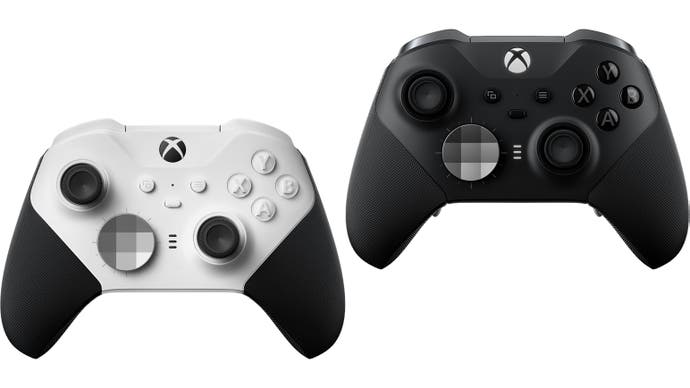
If you're willing to spend more on your controller, Microsoft's £159/$141 Elite Series 2 is the best controller we've tested thus far. Its controls are tight and responsive, with clicky face buttons and a generous grippy coating that ensures a great in-hand feel. There are plenty of customisation options too - you can add four paddles to the rear, swap out the sticks for four alternative options, adjust stick sensitivity and opt for a circular eight-way d-pad. The ability to toggle between three levels of trigger sensitivity with the flip of a switch is also impressive. There's even software like ReWASD that lets you rebind the paddles to keyboard commands.
The Series 2 also improves on its predecessor with a more modern design equivalent to the most recent standard Xbox One controller, including Bluetooth connectivity, a headphone jack and USB-C charging via the included stand or a USB-C cable. The rechargeable battery used here is arguably more convenient than the previous system that used AA batteries, but it's also not user replaceable. In total though, the generational changes here are overwhelmingly positive - and you can read more in our Elite Controller Series 2 review.
The £90/$115 Elite Series 2 Core is a distillation of the Elite Series 2, offering the exact same core features but leaving out the extras such as the charging dock and replacement sticks. This genius move means that you get an extremely responsive and well-built controller for a lower price and you can pick up the accessories later (£39/$39). For someone that used the default loadout on the Elite Series 2 99 percent of the time, this release makes a ton of sense.
Pros
- Incredible levels of hardware and software customisation
- Comfortable, precise feel with excellent tactile feedback
- Includes creature comforts like Bluetooth and USB-C charging
Cons
- Rechargeable battery isn't user replaceable
Best cheap PC controller: Turtle Beach React-R
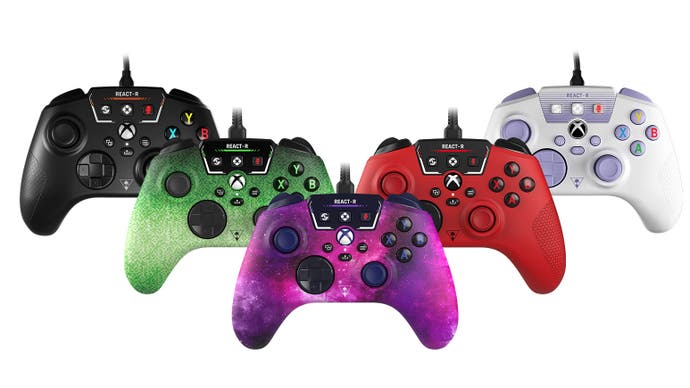
At £25/$30, the Turtle Beach React-R is one of the few name-brand controllers that comes in below the Xbox Series Wireless Controller or Sony DualSense PS5 Controller in terms of price. For that, you do get a surprising amount of functionality, including programmable rear buttons and convenient audio controls for superhuman hearing (an FPS-focused EQ), game/chat mix and microphone mute. These features work a treat, and the controller connects via a detachable 2.5m USB cable on both PC and Xbox consoles.
Build quality is reasonable throughout, despite the plastic design and bit of play in the triggers, while textured grips provide a comfortable fit for most hand sizes. Multiple colour options are also available, including standard black, red, an eye-catching SNES-inspired retro design in beige and purple, a pixellated green and a pink/purple nebula design.
However, there are some restrictions here too. The React-R is wired-only, which does at least make it lighter and removes the need to recharge or swap batteries. The responsiveness of the controls and the strength of the rumble are a touch worse than either the Series or PS5 controllers, making it more difficult to use in games that require precise inputs and detailed force feedback, such as more sim-oriented racing games. Still, for other genres these limitations are less of an issue and the React-R could make a lot of sense.
Pros
- Great price for a brand-name controller, given its good build quality and useful features
- Wired-only, so light design with no recharging or battery swapping required
- Looks much better than your average generic cheap-o controller, with multiple colour options
Cons
- No wireless connectivity, obviously
- Buttons and joysticks lack a touch of precision, while force feedback is also less detailed
Best Hall Effect controller: Razer Wolverine V3 Pro
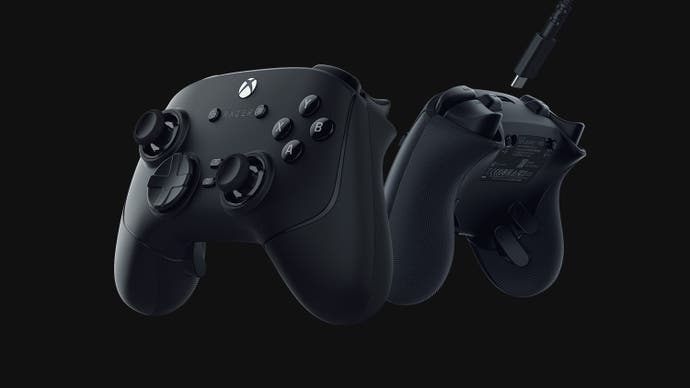
The £200/$199 Razer Wolverine V3 Pro is the best gamepad we've ever tested with Hall Effect sticks and triggers, a critical upgrade that allows for improved precision and hugely increased durability. These magnetic sensors don't degrade over time to the same degree that potentiometer-based sensors in traditional controllers do, and can be used without deadzones for an incredibly responsive feel.
This PC/Xbox controller boasts a huge list of other features too, with six extra buttons (four back paddles and two extra bumpers), hair triggers, low-latency 2.4GHz Hyperspeed wireless, hybrid membrane-mechanical face buttons and a huge amount of app-base customisability on Xbox and PC. There's even a tournament mode with a 1000Hz polling rate for wired play on PC. As with other premium controllers, you also get a neat carrying case with an extra-long (10-foot) cable and two replaceable thumbstick caps.
Pros
- Hall Effect joysticks and triggers and high-quality controls throughout for longevity and precision
- Balanced, heavy and well-built
- Wired and wireless connectivity on Xbox and PC
Cons
- One of the most expensive gamepads we've tested, though a wired-only Wolverine V3 Tournament Edition is available for half the price (£100/$100)
Best cheap Hall Effect controller: Gamesir G7 SE

The £50/$42 Gamesir G7 SE is an affordable Xbox/PC gamepad with Hall Effect thumbsticks and triggers. Hall Effect sensors use magnets rather than potentiometers, so they don't wear out over time - and they don't need the huge central deadzones that traditional controllers require to keep working as they experience wear and tear, meaning Hall Effect sticks can also feel much more precise.
The G7 SE has some other great ideas too. There are convenient programmable rear buttons, which can be physically locked to prevent accidental actuation in games that they're not needed, a mic mute button, plus textured grips and triggers.
The controller is generally quite comfortable to use for most hand sizes, and the triggers, face buttons and d-pad all feel as precise as the first-party Xbox gamepad - while the sticks feel more precise, making this a net upgrade. If you're happy to prioritise longevity and durability over wireless connectivity, this is an awesome alternative to the standard Xbox controller that should last much longer.
Pros
- Hall Effect joysticks and triggers, plus good-quality controls elsewhere, represent a net upgrade in responsiveness and longevity
- Slightly cheaper than Microsoft's standard Xbox controller
- Wired-only, so light design with no recharging or battery swapping required
- Some nice extra features, including two programmable rear buttons and swappable magnetic face-plates
Cons
- No wireless connectivity, obviously
Best third-party PC controller: Asus ROG Raikiri Pro
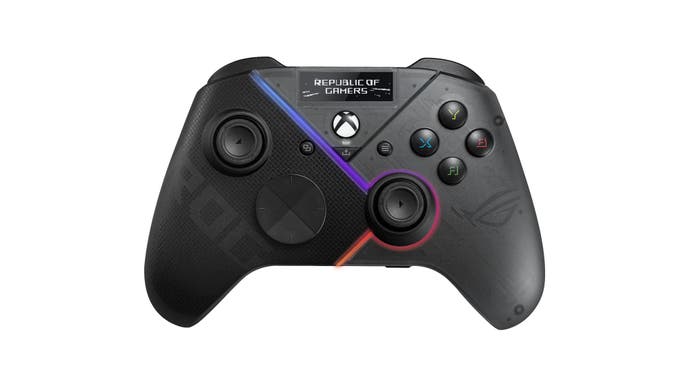
While Microsoft and Sony's long expertise with games consoles means that their controllers are the default option for many, there are also some great third-party alternatives worth considering. The £110/$140 Asus ROG Raikiri Pro is one of the best options, thanks to its clicky and satisfying face buttons, (optional) hair triggers and four extra rear buttons. Its modest dimensions are also comfortable for those with smaller hands, which isn't always a given.
The Raikiri Pro sports an OLED screen and RGB lighting, giving you information like battery levels and the current profile, and it can connect to PCs via 2.4GHz wireless, Bluetooth and USB, or Xbox consoles via USB only. (I particularly like that there's room for the 2.4GHz USB dongle inside the controller - something often eschewed.) There's even an ESS DAC built in to boost audio quality for headsets plugged into the 3.5mm port, along with a button to mute the microphone. The controller can be customised in Asus' Armoury Crate app, with button remapping, trigger deadzone adjustments and animation/lighting tweaks all possible.
Beyond a long feature list that helps to explain its premium price point, the Raikiri also just feels great to use for FPS and racing games alike, though the eight-way d-pad doesn't suit fighting games particularly well and ought to have been replaceable with a four-way alternative at this price point. Still, apart from the high price, this is a solid option - and I hope we see Asus expand what can be put on the OLED screen in future, as this could become a much bigger deal than it currently is.
Pros
- Looks and feels great
- Long list of useful features
- The best-looking controller we've tested
- Tri-mode connectivity for PC, wired for Xbox
Cons
- Expensive
- Eight-way d-pad not ideal for every game type
Most customisable PC controller: Scuf Envision Pro
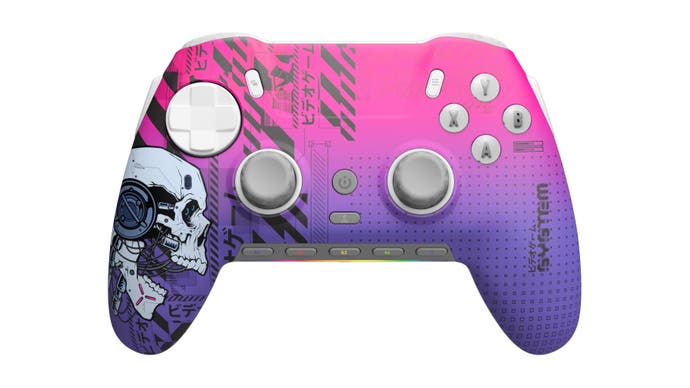
The £180/$180 Scuf Envision and Scuf Envision Pro are deeply customisable PC-first controllers with iCUE compatibility and RGB lighting, courtesy of Scuf owner Corsair. The Pro model is differentiated from the cheaper amateur with 2.4GHz Slipstream wireless connectivity, adjustable 'instant' triggers and grippier handles, but both come with clicky mechanical face buttons, pop-off sticks in a symmetric PS-style layout and tons of useful extra buttons: four on the back, two on the sides and five (!) on the front.
While you can get a standard version of the controller in a perfectly pleasant grey, black and orange colour scheme, you also have access to Scuf's powerful builder tool that lets you change up almost every aspect of the controller's appearance. My dream controller is reproduced above, with an eye-catching cyberpunk-y pink/purple faceplate and contrasting bone-white face buttons, sticks, d-pad, shoulder buttons and triggers. There are 11 options here, including less cosmetic changes like alternate stick types.
Of course, there's plenty of customisation after you've got the controller in your hands too, with iCUE allowing for not just stuff like sensitivity tweaks or button mapping/remapping, but proper macros, responsive RGB lighting and multiple profiles. If you have the Pro model, you also have a choice of two sticks in the box and those customisable triggers, which can be set to short-throw for rapid binary inputs (eg shooting in an FPS) or full-throw for that traditional analogue control (eg accelerating in a racing game).
Unfortunately, the triggers and the sticks don't use longer-lasting and more accurate Hall Effect sensors, which are now starting to pop up in gamepads both budget and premium.
The greatest strength and weakness of the Envision series are that they are rare PC-centric controllers with no compatibility with consoles or even Macs, iPhones and iPads. That's a shame, but it does allow for customisation options that are rarely offered amongst PC controllers - so it's a worthy effort all the same. I'd still recommend an Xbox or PS-compatible controller if you spend any significant amount of time on consoles in addition to PC, but for PC-only players this is a standout choice that feels exceptional to use.
Pros
- Can be customised for a look and feel entirely your own
- Both base and pro models include fully programmable buttons, mechanical switch buttons and added keys on the sides and back
- Instinct Pro variant offers wireless, adjustable triggers and more grip
- Has PC-specific functionality, including iCUE customisation and RGB lighting
Cons
- Extremely expensive once fully customised
- Not compatible with consoles, Mac or iOS - just PC and Android
- No Hall Effect sticks or triggers
Runner-up customisable controller: PDP Victrix Pro BFG
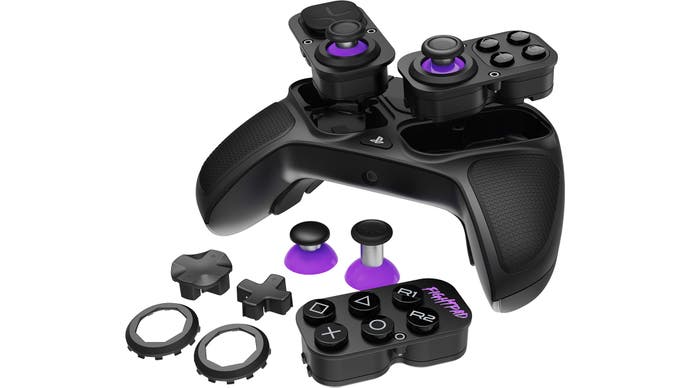
The £139/$149 Victrix Pro BFG is another nice option if you prefer a controller you can make your own, with some novel post-purchase customisation ideas. As you can see in the image above, the left and right modules can be unscrewed with an included tiny screwdriver and removed, allowing you to swap to a PlayStation style thumbstick layout or even replace the entire right side with the "fightpad", a six face button layout optimised for Tekken, Street Fighter and the like. The fightpad is pretty special, with bigger and clickier buttons, and makes the Pro BFG worth considering for fans of the genre.
There are plenty more options too. You can adjust the trigger length, swap between different d-pads and thumbstick tops, put in different length thumbsticks, and choose between circular or octagonal gates for each thumb stick. There are also programmable rear buttons, custom profiles, built-in audio controls and a tournament mode that locks out buttons that might accidentally take you out of the game. It's a very comprehensive assortment of features and options.
The build quality here is excellent too, with satisfyingly smooth triggers and slightly tactile face buttons. The whole unit feels pleasantly robust, and the weight is well balanced too. Unlike the previous Victrix Gambit, this is a wired and wireless controller - and thus different varieties exist for Xbox and PlayStation use; both work with PC too. I think there's enough here to justify the asking price!
Pros
- Excellent range of customisation options included
- Excellent build quality and interesting colour scheme
- Xbox and PlayStation 5 varieties available
Cons
- Too expensive if you don't use the extra functionality
- 20 hours of battery life is nothing special
- No Hall Effect sticks or buttons
Bonus - Best iOS/Android controller: Gamesir G8 Galileo
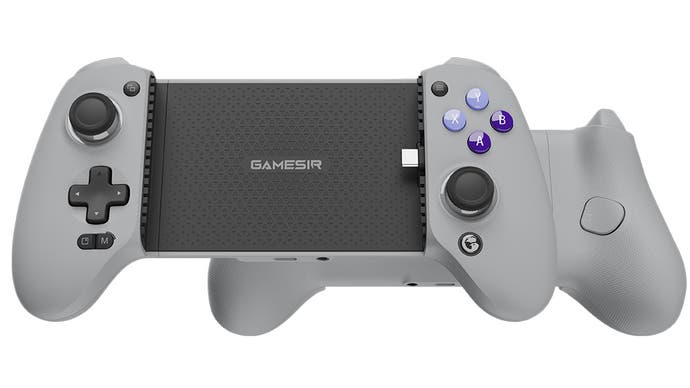
We don't have a specific article for Android and iOS controller recommendations, so I thought I'd add one here as a little extra. The best I've tested so far isn't from Razer or SteelSeries, though I have enjoyed their work in this category, but instead from Gamesir. This company is quickly making a name for itself and their £80/$80 Gamesir G8 Galileo backbone-style controller is an excellent choice thanks to its Hall Effect sticks and overall comfy and convenient design.
I tested the gamepad with a Google Pixel 6 in a range of titles/services including Diablo Immortal, Xbox Cloud Gaming and some emulators and was impressed by the overall comfort of the experience. This is miles better than using the touchscreen, with responsive tactile controls in a familiar layout, yet your fingers are still close enough to tap the screen if necessary to navigate the user interface or change games.
The Hall Effect sticks worked well here, and should last for ages without the stick drift that plagues potentiometer-based controllers. There are other nice touches too, like pass-through USB-C charging and a 3.5mm headphone port, 5mm of extra space for phones with trendy camera bumps
The only downside I discovered is that wired controller support is a little behind support for Bluetooth controllers, so some high-profile Android games like Call of Duty Mobile were complete non-starters.
Still, there's plenty here to be getting on with with native mobile games, streaming and emulation to consider, and playing on a powerful phone with the G8 Galileo represents a viable alternative to dedicated PC handhelds like the Steam Deck or ROG Ally with a different selection of games and arguably a more portable design, though the G8 is still fairly chunky at ~215x105x50mm when fully closed.
Pros
- Long-lasting and precise Hall Effect sticks and triggers
- Comfortable design with space for large phones and even small tablets or off-centre USB ports
- Works with USB-C phones, including Android phones and iPhone 15+
Cons
- More expensive than an Xbox Wireless or DualSense controller
- Wired controllers don't work in some high-profile games like Call of Duty
Best of the rest: other controllers we tested

To keep our recommendations manageable, we've opted for 10 controller suggestions in the main article above. Here are some brief thoughts on the other controllers we've tested, including a few options that nearly made it into the top slots.
Turtle Beach Stealth Ultra Wireless: This premium controller has a lot going for it, but ultimately just barely fell short of our top recommendations. We loved its accurate and responsive Hall Effect sticks and tactile micro switch face/shoulder buttons, and the ability to change your settings on the fly using the built-in screen is incredibly handy. However, the controller's build quality feels a bit low for the price point, and battery life isn't exceptional either at a rated 30 hours. You do at least get a very handy dock for drop-on recharging, which has a place to plug in the controller's wireless dongle - perfect for PC. The rear buttons here are a bit of a mixed bag too, with a nice click but relatively little travel - and I couldn't reach the P2 and P3 buttons with my usual grip style. This has dropped as low as £139, where it's a genuine contender, but at its current £179/$200 at the time of writing it's just too expensive.
Nacon Revolution 5 Pro: A premium wireless PlayStation 5 and PC gamepad with Hall Effect sticks and triggers, the R5P is solidly constructed with a long feature list - but it is a bit limited on PS5, where it doesn't support adaptive triggers and rumble and can't turn the console on due to Sony restrictions. The controller is heavy and wide, making it best suited for medium to large hand sizes, but still feels balanced and comfortable. Overall, a decent option that's largely held back by a top-tier price (£193/$199) that demands perfection.
Thrustmaster Eswap X2: This is another strong controller when it comes to customisation, with hot-swappable components - you can freely swap the position of each stick and the d-pad. As with earlier Eswap iterations, the build quality and responsiveness here are impressive given the modular design. The buttons on this model are nice and clicky too. If you're happy with a wired pad and want something with a ton of extra features, including back buttons, this is a few price drops away from real contention. You can check the current price on Amazon UK or Amazon US.
PowerA Spectra Infinity Enhanced Wired Controller: At £35/$34, this gamepad is about £15 cheaper than the official Microsoft Xbox One controller. You lose out on wireless connectivity and a tiny bit of build quality, but you gain edge and button lighting in seven colours, two programmable rear buttons and three-tier trigger locks. The trigger locks didn't work perfectly in our testing, with the most restrictive setting on both triggers resulting in different amounts of movement, but otherwise the controller delivers a reasonable gaming experience and looks good doing it. If the extra features are worthwhile for you and you're not interested in wireless connectivity, then this is a decent choice.
PowerA Moga XP Ultra: Another gamepad designed for mobile use but technically compatible with both Xbox and PC, this controller is quite adaptable indeed. You can even shed the lower portion of the controller to make it into a teeny-tiny pocketable unit, though the ergonomics are woeful. Best used with an Android smartphone clipped above, though beware that many games don't play nice with a wired controller connection - so Bluetooth is the way forward. Surprisingly expensive for this category at £88/$83, but there's nothing quite like it.
Nintendo Switch Pro Controller: This £49/$69 controller is a good first-party option with excellent battery life, but it is more expensive than many competitors, lacks analogue triggers and doesn't offer any compelling unique features beyond Switch compatibility and a cool see-through design.
Razer Raiju Mobile: While the $36 Raiju Mobile sports clicky buttons, good ergonomics and a built-in smartphone clip, its unusual default bindings on PC require manual remapping in each game. By contrast, the SteelSeries Stratus Duo works well on PC out of the box.
Microsoft Elite Controller (Series 1): The first-gen Elite was a great controller, but the Elite Series 2 and Series 2 Core offer more features and a better tactile feel at the same price. Only consider this one if you can find it in working order at a good price, or if the lack of a user-replaceable battery in the Series 2 is a deal-breaker for you.
Nacon Pro Controller 3: The design and build quality of this £72/$74 controller is subpar, with flabby shoulder buttons and lethargic sticks, but the real issue is the placement of the extra buttons. Rather than paddles, Nacon has opted for a quartet of small buttons built into the lower grips. This is convenient, in that you can reach these buttons comfortably, but they're all-too-easy to set off accidentally and hard to differentiate. That makes the NPC3 a hard sell in a competitive premium controller market.
So, there you have it. We will continue to evaluate new gamepads and controllers to keep our recommendations up to date, and we welcome your feedback in the comments below.
